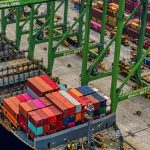The world economy has been a moderate growth path and started the global recovery. Economic activity has accelerated in some countries. There is an increase in global demand, which should remain dynamic. Developing market economies have experienced mixed economic performance. The pick-up in global demand momentum has been driven by investment demand. Exporting countries develop businesses that know how to gain a competitive advantage in the global market. Trade agreements can boost exports, but the competition they generate is detrimental to small domestic industries.
We are entering a new era, in which a series of innovations that take advantage of the Internet could have a major impact on trade costs. Global markets are in free fall with supply chain disruption and manufacturing falling to its lowest in decades.
Indian trade and its scenario:
India’s history of growth, since the 21st century, is remarkable. The Indian economy has come a long way since its economic ease and today ranks among the world’s leading economies. Over the past year, it has seen economic policy developments with the introduction of the Goods and Services Tax (GST) and the demonetization of higher banknotes. GDP growth in the first quarter of the current fiscal year fell to 5.7%, its lowest level since March 2014. India is expected to experience growth of 7.2% in this fiscal year, thanks to higher public spending and a recovery in the performance of the services sector.
India’s growth through international trade:
In recent years, India’s strong growth has been driven by a private sector. An encouraging phenomenon that has been observed. The emergence of a large number of investment-oriented small enterprises. Many of these companies have made efforts to expand their business. India’s economy is more globalized than one might imagine. As a result, India’s trade has multiplied by several since the liberalization of the economy. In the current global scenario, this appears to be a difficult task, concerted efforts should make so that India can achieve its trade target and realign its foreign trade policy with the new global trading system. While the global economic scenario is crucial, domestic factors are no less important in trade.
Integrate the value chain:
Most of the manufactured products, high-tech manufactures, that are part of GVCs are critical base products made in multiple countries. A robust transport and connectivity network supported by rapid entry/exit through port/customs is a prerequisite for manufacturing such products as delay can disrupt the entire value chain. India needs to focus on expanding its production capacity as well as adding values. Moving up the value chain while creating an enabling environment to account for a significant share of major exports world-class. This gain is even larger given that India’s labor force is expected to grow by around 110 million by 2020. The biggest challenge is to employ the surplus labor from agriculture in industry and services.
Summing up:
Overall, pickup in global growth is expected to help revive global trade. But downside risks such as the possible adoption of trade policies developed by market economies. As a result, there is a growing need for India and other emerging market economies, which rely on export-led economic growth, to take a proactive stance in favour of globalization and international trade. There is a need to no longer focus on exporting what we can, to items that are in demand. A demand-driven export basket variety approach could provide a strong boost to exports. While India has made remarkable progress in the recent past, it faces an even more difficult global environment. Getting India to reposition itself as an important engine of global economic growth is a difficult task, but possible.


